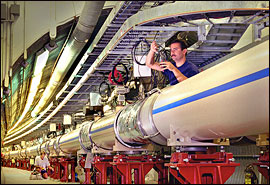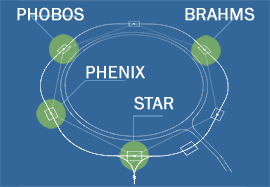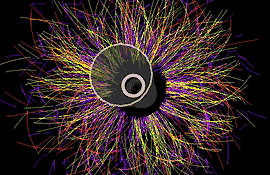




The Physics of RHIC
Physicists from around the world are using the Relativistic Heavy Ion Collider to explore some of Nature's most basic -- and intriguing -- ingredients and phenomena. Here's a look at the physics of RHIC in plain English.
Heavy Ion Collisions
RHIC is the first machine in the world capable of colliding heavy ions, which are atoms which have had their outer cloud of electrons removed. RHIC primarily uses ions of gold, one of the heaviest common elements, because its nucleus is densely packed with particles.
RHIC collides two beams of gold ions head-on when they're traveling at nearly the speed of light (what physicists call relativistic speeds). The beams travel in opposite directions around RHIC's 2.4-mile, two-lane "racetrack." At six intersections, the lanes cross, leading to an intersection. When ions collide at such high speeds fascinating things happen.
If conditions are right, the collision "melts" the protons and neutrons and, for a brief instant, liberates their constituent quarks and gluons. Just after the collision, thousands more particles form as the area cools off. Each of these particles provides a clue as to what occurred inside the collision zone. Physicists sift through those clues for interesting information.

1. Ions about to collide*
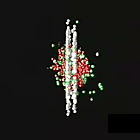
2. Ion collision
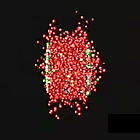
3. Quarks, gluons freed
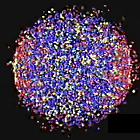
4. Plasma created
About Quarks & Gluons
To understand why RHIC collisions are scientifically interesting, it is important to know that scientists believe that all protons and neutrons are made up of three quarks, along with the gluons that bind them together.
Theory holds that for a brief time at the beginning of the universe there were no protons and neutrons, only free quarks and gluons. However, as the universe expanded and cooled, the quarks and gluons bound together and, for the next 13 billion years, remained virtually inseparable. RHIC is the first instrument humans have built that can take us "back in time" to see how matter behaved at the start of the universe.
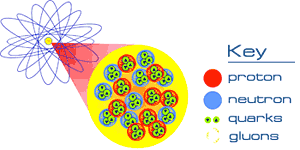
Physicists around the world are interested in RHIC collisions. The information found at RHIC can be applied in nuclear physics (the study of atomic nuclei), particle physics (the study of the atom's constituents), astrophysics (the study of stars and planets), condensed matter physics (the science of solid matter) and cosmology (the study of the universe).
* The ions appear as flat disks because of the relativistic effect called "Lorentz contraction".
Hotter than the Sun
RHIC collisions occur thousands of times per second. Each one acts as a microscopic pressure cooker, producing temperatures and pressures more extreme than exist now even in the cores of the hottest stars. Temperature inside a RHIC collision can be many thousand times the temperature of the sun.
But since the heavy ions in RHIC collisions are so small, the actual impact of the speeding ions on each other is about the same as the impact of a mosquito hitting a screen door on a summer evening. And, RHIC collisions last only a few billionths of a second.
RHIC collisions may be super-fast and super-hot, which makes them interesting to physicists, but they're too small and too brief to be dangerous.
Spin Physics
Protons are made of quarks and are held together by emitting and absorbing gluons. All of these particles have an intrinsic property known as spin. Physicists have long thought that the spin of a proton was simply the sum of the spins of its three component quarks. But experiments have shown that the quarks account for only about 20 percent of the proton's spin. What accounts for the missing 80 percent? RHIC is the world's only machine capable of colliding high-energy beams of polarized protons to investigate this question.
